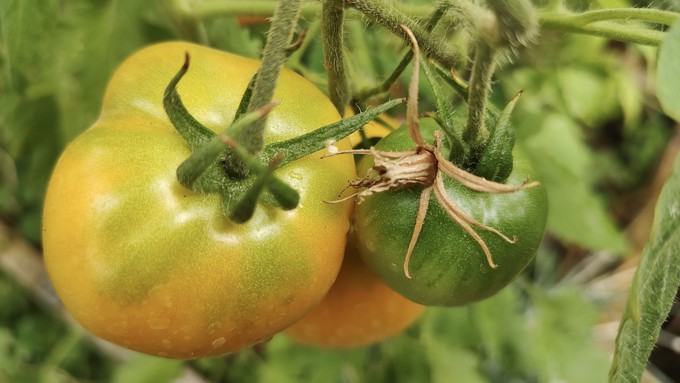
Heat spikes dried out flowers or caused plants to abort fruit

On this Chef's Choice Orange tomato plant, one blossom didn't pollinate but others fortunately did. Heat and low humidity affect tomato pollen. Debbie Arrington
It’s a tale of two harvests. Some Sacramento-area gardeners are having bumper tomato crops. Others, not so much.
Here at Sacramento Digs Gardening, the kitchen counters are covered with big fat slicers. Both Kathy and I have had excellent tomato seasons.
But I’ve heard from several other gardeners who saw their vines struggle.
“My tomato crop is the worst ever this year,” wrote reader Robin Wham. “Are others having this challenge? Was it the long spring?”
Maybe – if tomato vines were planted in March or early April. That long, cool spring with cold soil temperatures did those plants no favors.
Timing and temperature are key to tomato success. When they transplant their tomato seedlings outdoors, gardeners gamble on weather reliability.
This season, later may have been better. Tomatoes planted in mid- to late April and mid-May seemed to produce the most fruit. Their growth spurts and bloom cycles seemed in sync with temperature ups and downs.
April 21 through 29 saw a streak of afternoon days in the 80s – perfect tomato weather. That sweet spot got transplants off to a strong start. (That's when my vines went in the ground.)
But Sacramento started May with another cold streak; overnight lows dipped into the 40s on the first eight out of 11 nights. That challenged plants set out during early May. Tomatoes won’t set if nighttime temperatures are below 55 degrees.
It wasn’t until May 12 when Sacramento finally saw an upswing in temperatures and more typical growing conditions. Tomatoes planted after that date seemed to flourish, too.
June also featured good tomato-growing weather with most afternoons in the 80s. Tomato plants that were mature enough to produce flowers had good fruit set and started producing ripe tomatoes in July.
When it comes to setting fruit, tomatoes are fickle about temperature. Flowers are usually pollinated with the help of a light breeze or the vibration of bumblebees.
Tomato pollen dries out when temperatures are above 95 degrees; it won’t stick. Unpollinated flowers dry up.
Even if pollinated, flowers may drop off in high heat. University of Nevada research showed tomato plants will abort new fruit if exposed to more than four consecutive hours over 100 degrees.
July saw plenty of triple-digit hours. Sacramento reached at least 100 degrees on eight days. Those high temperatures prevented new tomatoes from setting and some vines just shut down completely.
So far in August, we’ve had eight days over 100 degrees. That fried new flowers on the vine. Instead of forming new fruit, they shriveled up and dropped off.
One more factor in tomato set: Fertilizer. Tomatoes that get too much nitrogen produce lots of vine but little fruit. During fruit formation, hold back on fertilizer except for a little bone meal.
As long as vines produce flowers, there’s hope. “Average” days in the 90s are forecast for the remainder of August and through Labor Day weekend, and soil remains warm. Those late summer blooms could produce autumn tomatoes.
Share your tomato updates
How are your tomatoes producing this season? Tell us about your 2023 crop including what and when you planted. We’ll follow up with another report.
Send your tomato updates to: SacDigsGardening@gmail.com.
Comments
0 comments have been posted.Sacramento Digs Gardening to your inbox.
Sites We Like
Garden Checklist for week of July 21
Your garden needs you!
* Keep your vegetable garden watered, mulched and weeded. Water before 8 a.m. to reduce the chance of fungal infection and to conserve moisture.
* Feed vegetable plants bone meal, rock phosphate or other fertilizers high in phosphate to stimulate more blooms and fruiting. (But wait until daily high temperatures drop out of the 100s.)
* Don’t let tomatoes wilt or dry out completely. Give tomatoes a deep watering two to three times a week.
* Harvest vegetables promptly to encourage plants to produce more. Squash especially tends to grow rapidly in hot weather. Keep an eye on zucchini.
* Pinch back chrysanthemums for bushy plants and more flowers in September.
* Remove spent flowers from roses, daylilies and other bloomers as they finish flowering.
* Pinch off blooms from basil so the plant will grow more leaves.
* Cut back lavender after flowering to promote a second bloom.
* It's not too late to add a splash of color. Plant petunias, snapdragons, zinnias and marigolds.
* From seed, plant corn, pumpkins, radishes, winter squash and sunflowers.